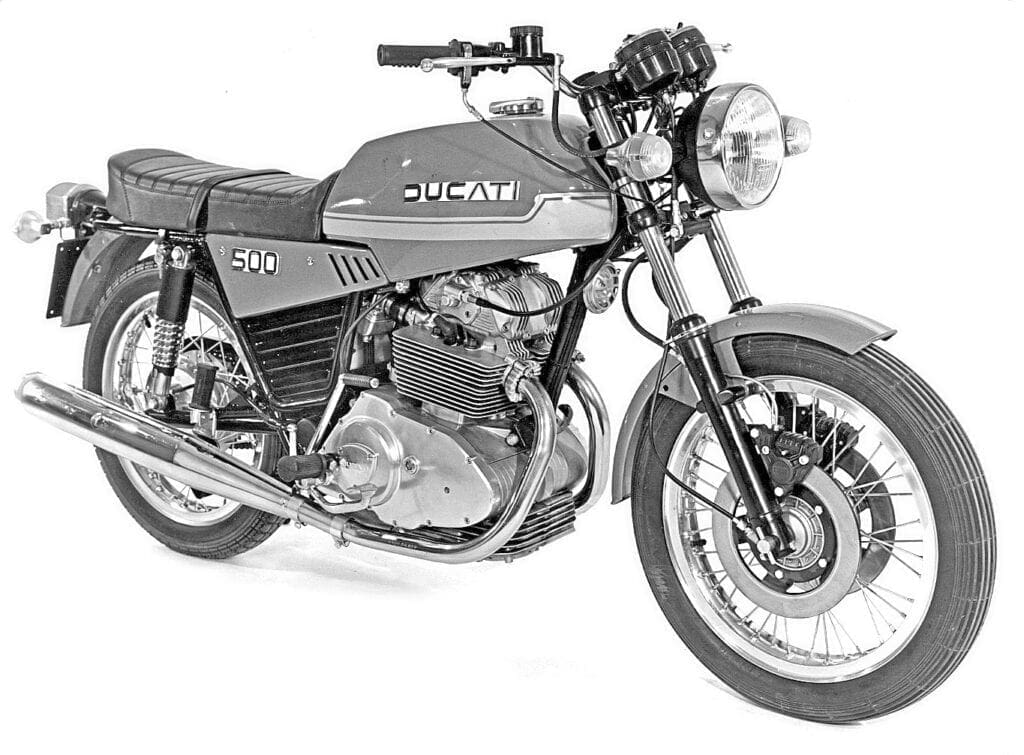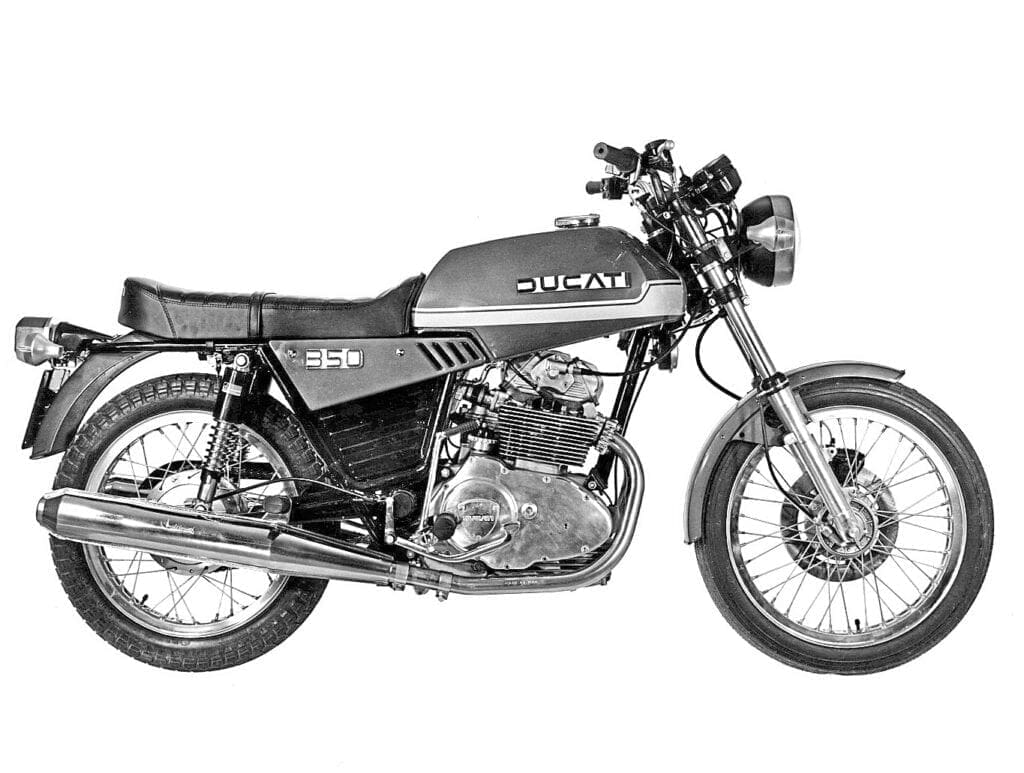Steve Cooper strays from the Japanese path once more as he examines the reasons why Ducati’s controversial ultra-short-stroke parallel twins were never going to succeed amid motorcyclists’ ever-changing expectations of the 1970s.
Think of Ducati and you’ll be conjuring up images of rorty V-twins and lusty singles. Both will bellow in their own inimitable way, but you’d instantly know that they came from the same stable.
If someone told you the offbeat exhaust notes of a 180-degree four-stroke parallel twin also came from the same factory, you might, understandably, do a double-take. Surely such sets-ups are mostly Japanese in origin and have nothing to do with the famous Bologna factory?
Can you really marry sushi with pasta and get away with it? As Ducati found out to its cost, the answer was an unequivocal ‘No’!
Let’s go back to the earlier part of the 1970s: Ducati had found success with its bevel-drive 750 V twins – in fact they had revitalised a company that was teetering on the edge of an abyss.
Sales were good, but the machines were either very focused singles or expensive, high-end V-twins with no middle ground.
The management board decided the company needed a practical middleweight, and came up with the notion of parallel twins that would be easy to make and cost-effective – in theory at least.
When the plan was run by legendary engine designer Fabio Taglioni, he threw up his hands in horror and refused to be part of the programme.
Instead, he dumped the management board’s idea firmly in the lap of his assistant, Bruno Tumidei – after all, that’s what assistants are for – but the truth is that Taglioni had already offered Ducati a Honda-beating parallel twin almost a decade earlier and had been rudely rebuffed.
Hell hath no fury like an Italian designer shunned!
Tumidei stepped up to the plate and did his best, turning out a pair of motors at 350 and 500c. Both were massively over-square (71.8 x 43.2mm and 78.0 x 52.0mm) and designed to rev north of eight grand.
The ultra-short strokes were quite possibly influenced by Benelli’s 650 Tornado, which also revved its heart out for a twin.
Initially Desmodromic valve actuation was passed over in favour of dual springs to each of the four valves, with the whole thing operated via a cam chain.

These were Ducatis like nothing before them. Styling was by Giorgetto Giugiaro of car designers Italdesign of Turin and proved, once again, that car designers know little about motorcycles (cf Odell Design and the infamous bread bin BSA/Triumph triples).
The strange globular tank was at odds with the slabby side panels, and public reaction was less than favourable. Italjet designer Leo Tartarini was quickly called in and he restyled the bikes with a Darmah-style makeover.
The satin black sidepanels still raised eyebrows, but at least the bikes now looked like Ducatis.
At first the bikes were badged as GTLs, fitted with wire wheels and running an open-bottomed frame that used the massive engine cases as part of the chassis.
This feature remained until the end of production, but the single downtube of the GTLs was soon replaced by a stronger triangulating pair of downtubes.
This, then, was the basic layout for what became known as the GTV range when equipped with some rather smart six-arm, twin-spoke, alloy wheels.
From the off the 350 was noted pointedly for being too heavy and too slow. It had been created to exploit a beneficial capacity tax rate within the domestic market, but sadly it was never going to be a viable challenge to the likes of Yamaha’s seminal RD400 or even Honda’s CB360 G5.
Smooth and pleasant to ride, with amazing handling and great Brembo brake, the Ducati simply didn’t have the legs and the 350 flopped spectacularly. The 500 received grudging praise in GTL format, and was sold to home market police forces, where its reliability soon came into question.
Upping the ante, the inevitable happened when Ducati installed the almost obligatory Desmodromic valve gear to the 500, which gave the motor that all-important edge with high-speed valve control. To all intents and purposes this was a machine that might well have been billed as Italy’s answer to the famous Honda Black Bomber, both running radical methods of valve control.
To a fair degree, and following the laws of physics, the Ducati followed the same form – notably it was vibratory at lower revs but smoothed out as engine speed picked up.
Unfortunately, the vibrations became most overtly apparent between 55 and 70mph, effectively just where most people would have ridden the bike. Above 70mph the engine smoothed out significantly, enabling high-speed riding that was likely to grab the attention of the authorities.
A little more thought and some considered rebalancing of the crankshaft might well have addressed this key issue, but what couldn’t be ignored was the way the chassis performed. In true Italian tradition, the bike handled like little else, offering a masterclass in frame geometry and suspension design, and with a trio of class-leading Brembos, braking was similarly in the top league.
Despite its obvious merits, the bike received a lukewarm reception pretty much globally. Even if it said Ducati on the tank, it didn’t really look or sound like one. Importers and concessionaires found bikes still sitting in showrooms two years later with no takers. The exchange rates against the lira were hardly favourable either, making the bike some 20% more expensive than its peers.

One of the few countries where both the GTL and GTV found favour was Spain, where they were produced under licence by Mototrans. Using strong artistic interpretations, the Spanish restyled and reworked the basic designs to deliver motorcycles targeted specifically at the local enthusiast.
Realistically, the end results were visually much less challenging than either the Giorgetto Giugiaro or Leo Tartarini designs and looked more in keeping with the trends of the period.
Ultimately, the bikes were ill-conceived and poorly designed. Caps fitted to the ends of the camshafts regularly fell off, facilitating a devastating and terminal drop in oil pressure. The cam chain tensioner, just like so many others of the period, was not really up to the job, and the bikes’ overall build quality varied from just about OK all the way down to totally dire.
Finally, the plain bush main bearings wore badly, allowing further oil pressure issues in the same style offered by BSA’s A65s. Even when fully sorted, the bikes were the wrong machines at the wrong time, offered to a clientele that really didn’t want yet another half-litre, four-stroke parallel twin, no matter how good it handled.
Only a handful were ever imported into the UK as the then agents, Coburn & Hughes, were singularly unconvinced that they had any potential. Know that the author has only ever seen two examples in since their launch and ponder why. Could it be that the first was sitting in the gutter waiting for the recovery truck and the second was up for sale by a disheartened owner?
Ducati parallel twins were never the company’s finest hour!
Read more News and Features at www.oldbikemart.co.uk and in the latest issue of Old Bike Mart – on sale now!





